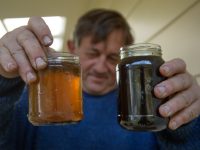Like many things in life there is often more than one way to do something and feeding your plants with liquid from the worm farm is one example of these. Worm castings are packed with nutrients and beneficial microorganisms that are known to improve soil health and plant growth. When water is run through a worm farm, and collected from the outlet, it picks up particles of worm castings and decaying matter. This liquid fertiliser can then be diluted to the colour of weak tea, hence why it is sometimes referred to as “worm tea.” Personally, I like to refer to it as leachate because I think this name more accurately describes the process of extracting it from the worm farm in this way. This substance is what I use on the plants in my garden both edible, native and exotic with very positive results.
Like any other manure, fertiliser or other decomposing organic material, liquid collected straight from the worm farm can also contain potential pathogens, which are not meant for human consumption. If using this to fertilise your edible plants, I recommend washing them thoroughly before eating. I would always recommend washing any fruits or vegetables before consumption regardless.
Another way to create liquid fertiliser from the worm farm is to create a “brew”, which is what some people call worm tea. This process involves collecting finished worm castings from the farm and placing them into a porous sack or bag (an old cotton sock or something similar could do the trick here.) The sack of worm castings is then put into a bucket of water, like a tea bag. An aerator, such as a fish tank bubbler and some molasses is also put into the bucket. The mixture is left to brew and bubble for approximately 24-48 hours. People who brew “worm tea” in this way believe that the beneficial microbes feed on the molasses and thrive in the oxygen rich environment created through the bubbling process. I often talk of compost and worm farm aeration because the presence of oxygen within this environment creates what we call an “aerobic” state. Worms and beneficial microorganisms tend to do very well in an aerobic environment. When a compost or worm farm is not aerated it can become “anaerobic” (lacking in oxygen) and this is when we may see the less desirable organisms become more prevalent. The theory behind brewing tea in this bubbling/molasses way is to tip the balance in the liquid extracted from a worm farm to a more favourable state. But does it really make that much of a difference? I have heard some claims go as far as saying leachate from a worm farm is actually harmful and shouldn’t be used at all. In my 35 years of collecting and using this liquid on my plants I’ve not seen any negative affects. On the contrary, I’ve had nothing but good results. With this in mind, I’d like to put both to the test on some home grown vegetables. Stay tuned

